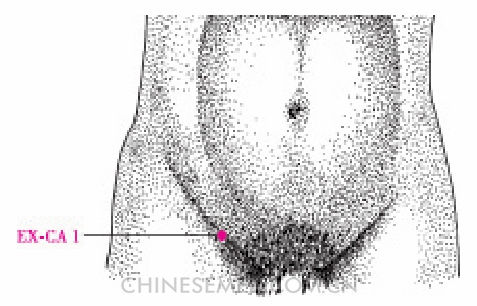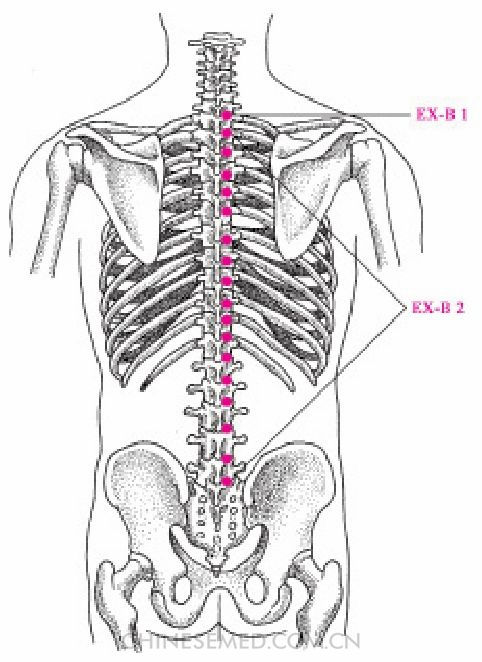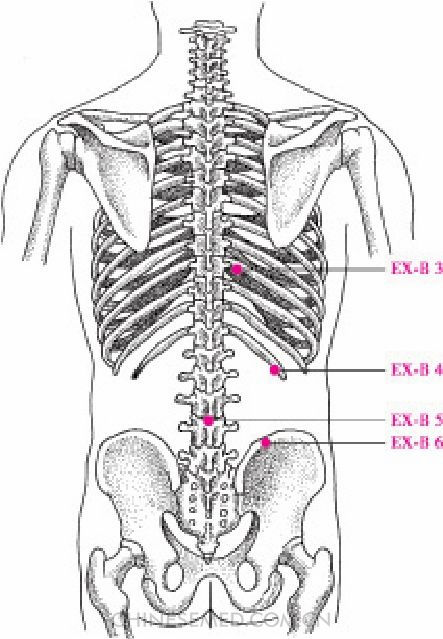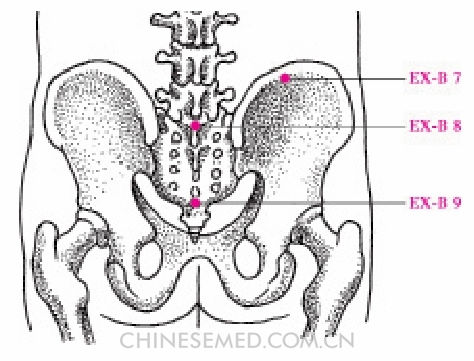Zǐ Gōng (EX-CA 1, 子宫)
Location. On the lower abdomen 4 cun below the center of the umbilicus and 3 cun lateral to the anterior midline (Pic. 3-114).

Location.method. The point is 3 cun lateral to RN 3 (zhōng jí).
Actions. Regulate menstruation, rectify blood, and raise the sinking.
Indications. Irregular menstruation, dysmenorrhea, prolapsed uterus, dysfunctional uterine bleeding, infertility, endometritis, pelvic inflammation; pyelonephritis; cystitis; appendicitis.
Manipulation. Acupuncture: 1. Insert perpendicularly 0.8~1.2 cun. 2. Needle transversely 1.5~2.5 cun toward the pubic symphysis to cause local soreness and distention that radiate to the external genitalia. Moxibustion: Use 5~7 cones of cone moxibustion, 10~15 minutes with a moxa stick.
Precautions. Avoid puncturing the membrane wall of the abdominal cavity. Deep insertion might puncture the organs and cause bleeding or infection.
Extra Points of the Back
Dìng Chuǎn (EX-B 1, 定喘)
Location. In the region of the vertebral column below the spinous process of the seventh cervical vertebra and 0.5 cun lateral to the posterior midline (Pic. 3-115).

Location.method. The point is 0.5 cun lateral to DU 14 (dà zhuī).
Actions. Relieve panting and cough, and diffuse and regulate the lung.
Indications. Bronchitis, bronchial asthma, and whooping cough; soft tissue disorders of the shoulder and back; stiff neck.
Manipulation. Acupuncture: Needle perpendicularly or obliquely 0.5~1.0 cun to cause local soreness and distention that might radiate to the shoulder, back, or chest. Moxibustion: Use 3~5 cones of cone moxibustion, or use warming needle moxibustion for 20 minutes, or 5~10 minutes with a moxa stick; medicinal and natural moxibustion may be used.
Precautions. See jǐng bǎi láo (EX-HN 15).
Jiā Jĭ (EX-B 2, 夹脊)
Location. Along the thoracic and lumbar spinal cord fanking the spinous processes from the first thoracic to the fifth lumbar vertebra and 0.5 cun lateral to the posterior midline; 17 bilateral points (Pic. 3-115).
Actions. Regulate zang-fu organs, and ease joint movement.
Indications. These points have a wide range of indications. Those on the upper thorax treat heart, lung, and upper limb disorders; those on the lower thorax treat stomach and intestinal disorders; those at the waist treat lumbar vertebrae, abdomen, and lower limbs.
Manipulation. Acupuncture: 1. Needle perpendicularly 0.3~0.5 cun. 2. Insert obliquely 1.5~2.5 cun toward the spinal column. 3. Needle transversely 2~3 cun, upward or downward to penetrate the points. Moxibustion: Use 3~7 cones of cone moxibustion or 5~15 minutes with a moxa stick.
Precautions. See jǐng bǎi láo (EX-HN 15).
Wèi Wǎn Xià Shù (EX-B 3, 胃脘下俞)
Location. On the back level with the inferior border of the spinous process of the eighth thoracic vertebra, 1.5 cun lateral to the posterior midline (Pic. 3-116).

Actions. Harmonize the stomach, dissolve phlegm, rectify qi, and relieve pain.
Indications. Gastritis, pancreatitis, diabetes.
Manipulation. Acupuncture: Insert obliquely 0.3~0.5 cun towards the spinal column to produce local soreness and distention that radiate to the lateral chest and abdomen. Do not insert perpendicularly or too deeply to avoid puncturing the pleura and lung. Moxibustion: Use 5~7 cones of cone moxibustion or 5~10 minutes with a moxa stick.
Precautions. When needling wèi wǎnxià shù (EX-B 3), it is not advisable to insert perpendicularly or laterally forward after the needle enters the muscle layer. In order to avoid puncturing the chest cavity, the needle should be inserted along the long axis of the rib following the external or superior and inferior border. To avoid puncturing the parietal pleura, do not penetrate the intercostal muscle.
Modern clinical observation and research. In an RCT comparing acupuncture, moxibustion, and acupuncture with moxibustion in insulin-dependent diabetes, wèi wǎn xià shù (EX-B 3) was used as the treatment point. In all three groups, clinical symptoms, fasting blood-glucose, and urine glucose improved; cholesterol, triglycerides, and low density lipoprotein levels decreased (P<0.05); and high density lipoprotein increased (P<0.05). Improvement was greatest in the combined group (P<0.01).1
Pǐ Gēn (EX-B 4, 痞根)
Location. In the lumbar region level with the inferior border of the spinous process of the first lumbar vertebra, 3.5 cun lateral to the posterior midline (Pic. 3-116).
1 Liao H, Xi P, Chen Q, Yi L, Zhao Y. Clinical research on the treatment of diabetes with acupuncture, moxibustion, and acupuncture with moxibustion at wèi wǎn xià shù (EX-B 3) 针刺、艾灸、针加灸胃脘下俞穴治疗糖尿病临床观察. Chinese Acupuncture & Moxibustion. 2007; 27(7): 482-4.
Location.method. The point is 0.5 cun lateral to BL 51 (huāng mén).
Actions. Regulate qi, dissolve stasis, disperse masses, rectify qi, and relieve pain.
Indications. Gastrospasm, gastritis, gastrectasia, hepatitis, hepatosplenomegaly; hernia; nephroptosis; lumbar muscle strain.
Manipulation. Acupuncture: Insert perpendicularly 0.5~1.0 cun to produce local soreness and distention that radiates to the waist. Moxibustion: Use 5~7 cones of cone moxibustion, or use warming needle moxibustion for 20 minutes, or 5~10 minutes with a moxa stick.
Precautions. If the organs are punctured, there will be bleeding in the local area, so do not needle pǐ gēn (EX-B 4) too deeply, especially in thin people, and control the needle so that it does not exceed the quadratus lumborum.
Xià Jí Shù (EX-B 5, 下极俞)
Location. In the lumbar region on the posterior midline and below the spinous process of the third lumbar vertebra (Pic. 3-116).
Actions. Strengthen the lumbar and reinforce the kidney.
Indications. Nephritis, enuresis; enteritis; lumbar muscle strain.
Manipulation. Acupuncture: Needle perpendicularly 0.5~1.0 cun to cause local soreness and distention; numbness and electric sensations might radiate to the lower limbs. Moxibustion: Use 5~7 cones of cone moxibustion, or use warming needle moxibustion for 20 minutes, or 10~20 minutes with a moxa stick.
Yāo Yí (EX-B 6, 腰宜)
Location. In the lumbar region level with the inferior border of the spinous process of the fourth lumbar vertebra, 3 cun lateral to the posterior midline (Pic. 3-116).
Location.method. This point is 3 cun lateral to DU 3 (yāo yáng guān).
Actions. Strengthen the lumbar and reinforce the kidney.
Indications. Lumbar soft tissue injury, low back pain, profuse uterine bleeding, spinal myospasm.
Manipulation. Acupuncture: Needle perpendicularly 1~1.2 cun or transversely 2.5~3 cun toward the spinal column. Moxibustion: Use 5~10 cones of cone moxibustion or 15~20 minutes with a moxa stick.
Yāo Yǎn (EX-B 7, 腰眼)
Location. In the lumbar region level with the inferior border of the spinous process of the fourth lumbar vertebra in the depression 3.5 cun lateral to the posterior midline (Pic. 3-117).

Location.method. The point is 3.5 cun lateral to DU 3 (yāo yáng guān) at the level of the iliac crest. When the patient is standing upright, it is in the round depression level with DU 3.
Actions. Strengthen the lumbar and reinforce the kidney.
Indications. Urogenital system disorders such as orchitis, enuresis, and nephritis; lumbar muscle strain.
Manipulation. Acupuncture: Needle perpendicularly 0.5~1.0 cun to produce local soreness and distention that sometimes radiates to the hip. Moxibustion: Use 5~7 cones of cone moxibustion or 5~10 minutes with a moxa stick.
Shí Qī Zhuī (EX-B 8, 十七椎)
Location. In the lumbosacral region on the posterior midline in the depression below the spinous process of the fifth lumbar vertebra (Pic. 3-117).
Location.method. The point is in the depression below the spinous process of the lumbar vertebra one vertebra below DU 3 (yāo yáng guān).
Actions. Strengthen the lumbar, reinforce the kidney, and rectify the uterus.
Indications. Irregular menstruation, dysmenorrhea, functional uterine bleeding; hemorrhoids; sciatica; poliomyelitis syndrome; lumbosacral pain.
Manipulation. Acupuncture: Needle perpendicularly 0.5~1.0 cun to cause local soreness and distention that radiates to the lower limbs. Moxibustion: Use 3~5 cones of cone moxibustion, or use warming needle moxibustion for 20 minutes, or 10~20 minutes with a moxa stick.
Yāo Qí (EX-B 9, 腰奇)
Location. In the sacral region 2 cun above the apex of the coccyx in the depression of the sacral horn (Pic. 3-117).
Actions. Calm fright and tranquilize the mind, extinguish wind and relieve pain.
Indications. Epilepsy, insomnia, headache; constipation.
Manipulation. Acupuncture: Keep the needle tip upward and needle transversely 1.0~2.0 cun to cause local soreness and distention that radiates upward to the head. Moxibustion: Use 3~5 cones of cone moxibustion, or 5~10 minutes with a moxa stick.

